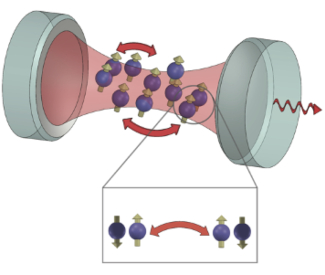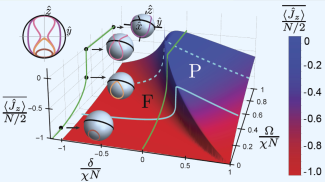Quantum many-body simulations with a strontium standing-wave cavity system
We have observed the emergence of infinite range interactions between atoms. The interactions are mediated via the cavity mode as an interaction bus into which atoms can emit a photon and another atom can absorb it. Remarkably, this process can be mapped onto a spin-exchange process, opening the door to exploring a host of quantum many-body simulations, one of the core thrusts of today's quantum science. AMO systems such as our opens the door to not only emulating systems in condensed matter, but to also realize simulations of phenomena that are not accessible in solid state systems. These systems also sit at the intersection of precision quantum sensing and many-body physics, opening the door to cross-fertilizing what would normally be considered distinct and separate fields of physics.
Spin Exchange on a milliHertz transition
We have observed strontium atoms undergoing spin-exchange with the effective spin down the ground state and spin up the excited state with a milliHertz radiative linewidth. Such an interaction might be harnessed in the future to protect quantum coherence or realize entangled states.
Out of Equilibrium Dynamical Phase Transition
Traditional quantum condensed matter systems explore ground state properties. Our atom-cavity system allows to explore such physics, but also to place the system out of equilibrium to explore new types of phase transitions. Recently we were able to observe a phase transition in the effective magnetization that arises from the competition between single-particle and collective physics.




 The Physics Frontiers Centers (PFC) program supports university-based centers and institutes where the collective efforts of a larger group of individuals can enable transformational advances in the most promising research areas. The program is designed to foster major breakthroughs at the intellectual frontiers of physics by providing needed resources such as combinations of talents, skills, disciplines, and/or specialized infrastructure, not usually available to individual investigators or small groups, in an environment in which the collective efforts of the larger group can be shown to be seminal to promoting significant progress in the science and the education of students. PFCs also include creative, substantive activities aimed at enhancing education, broadening participation of traditionally underrepresented groups, and outreach to the scientific community and general public.
The Physics Frontiers Centers (PFC) program supports university-based centers and institutes where the collective efforts of a larger group of individuals can enable transformational advances in the most promising research areas. The program is designed to foster major breakthroughs at the intellectual frontiers of physics by providing needed resources such as combinations of talents, skills, disciplines, and/or specialized infrastructure, not usually available to individual investigators or small groups, in an environment in which the collective efforts of the larger group can be shown to be seminal to promoting significant progress in the science and the education of students. PFCs also include creative, substantive activities aimed at enhancing education, broadening participation of traditionally underrepresented groups, and outreach to the scientific community and general public.